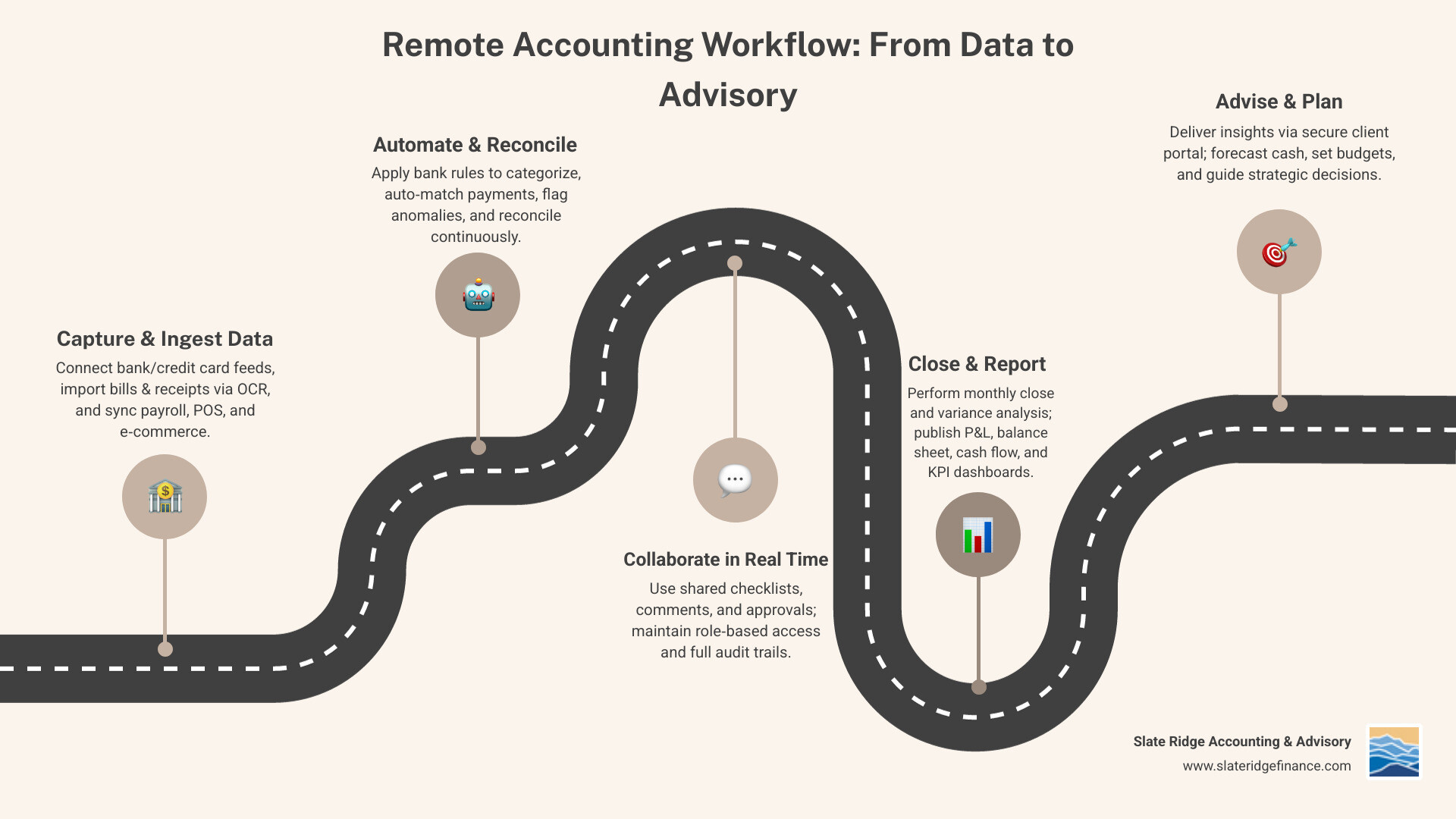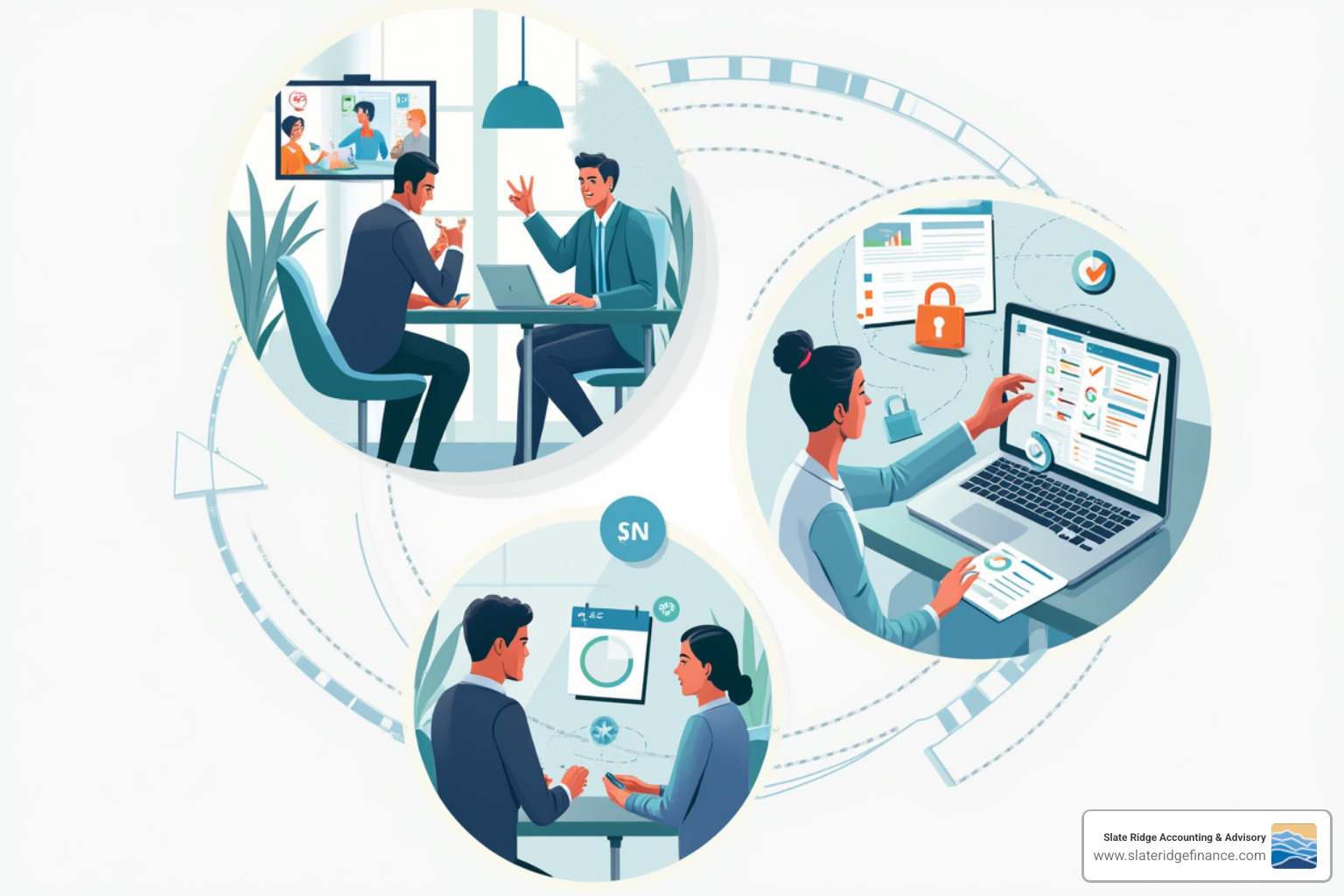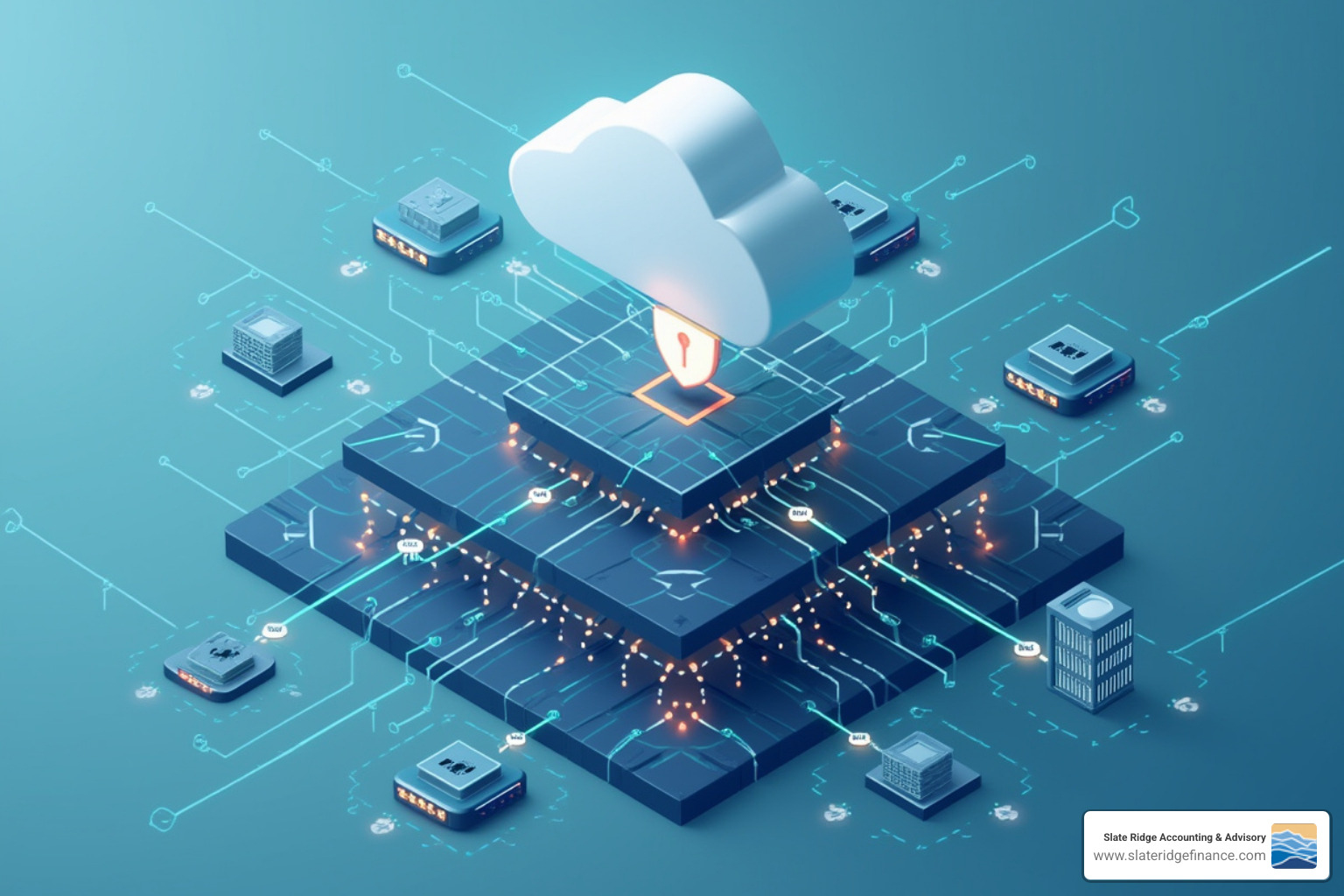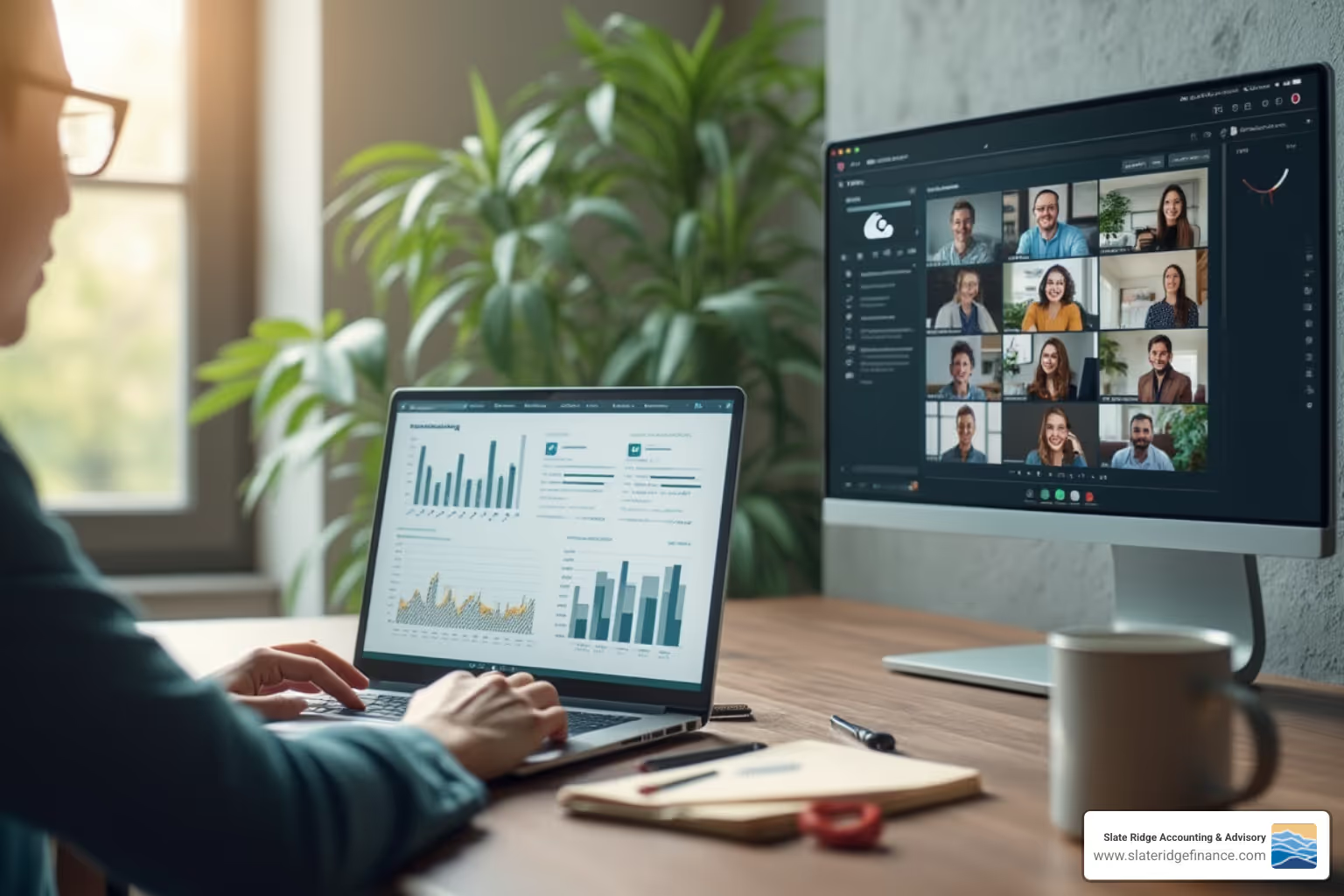Why Remote Accounting Solutions Are Changing Business Operations
Remote accounting solutions combine cloud technology with skilled global talent to deliver comprehensive financial services without geographical boundaries. These solutions enable businesses to access expert accounting services through secure digital platforms, providing real-time collaboration, automated workflows, and strategic insights.
Quick Overview of Remote Accounting Solutions:
- Definition: Cloud-based platforms + remote expert teams delivering full accounting services
- Core Services: Bookkeeping, payroll, tax preparation, financial reporting, and advisory
- Key Benefits: Cost savings, scalability, access to specialized talent, real-time data
- Technology: Secure cloud platforms with automation, shared dashboards, and mobile access
- Security: Enterprise-grade encryption, multi-factor authentication, and compliance certifications
- Ideal For: Small to medium businesses seeking professional accounting without overhead costs
The numbers tell the story of this change. Over 4.2 million subscribers use platforms like Xero, while thousands of accountants rely on remote solutions daily. One user reported that "moving to Xero has saved me eight hours of paperwork each week," highlighting the efficiency gains possible with modern remote accounting.
What makes remote accounting different from simply using cloud software? It's not just about the technology - it's about combining that technology with skilled professionals who can deliver results. While cloud software gives you the tools, remote accounting solutions provide the complete package: the right people using the right platforms to handle your financial needs.
This shift represents more than convenience. It's about accessing expertise that might not be available locally, scaling your financial operations without hiring overhead, and freeing up your time to focus on growing your business instead of managing spreadsheets.
The traditional model of hiring in-house accounting staff or working with local firms is being challenged by a new approach that offers better access to talent, more flexible pricing, and often superior results through specialized expertise and modern workflows.

Remote accounting solutions terminology:
Remote accounting solutions: what they are and what they are not

Remote accounting solutions are more than cloud software or a bookkeeper working from home. At Slate Ridge, they combine three pillars: people, platforms, and process. You get credentialed professionals, secure cloud tools that integrate, and documented workflows with SLAs that ensure reliable delivery.
With a software login, you still do the work. With our Virtual Accounting, we work with you in shared systems and timelines so you get real-time visibility, predictable closes, and accountable results.
How remote differs from cloud-only
Cloud apps are the toolbox; remote accounting adds the expert who uses it. Instead of emailing files or guessing at categorization, you get shared workflows, real-time collaboration, and approval chains that create a built-in audit trail. Role-based access ensures clarity: preparers prepare, reviewers review, and leaders focus on insights.
How remote differs from traditional in-house accounting
Remote models replace fixed overhead with scalable capacity. You avoid hiring and backfills while getting outcome-based delivery against published SLAs. Governance is embedded from day one with documented processes, checklists, and audit-ready trails.
Business problems solved by remote
- No more file transfer headaches or version confusion—everyone works in one source of truth.
- Capacity flex for peak seasons and projects without long hiring cycles.
- Faster time-to-close by combining automation with experienced reviewers.
Who should adopt Remote accounting solutions?
- Small businesses that want professional accounting without full-time headcount.
- Growing firms that need controller-level work before a full finance team.
- Companies with interim gaps or implementations that require short-term lift.
- Multi-entity and project-based teams that need consolidated, actionable reporting.
What you can deliver remotely and the tech stack that makes it work
Remote accounting solutions now cover nearly every finance function—often faster and with fewer errors. You’re not just getting data entry; you’re getting a coordinated accounting department delivered through the cloud. See our overview of Cloud Accounting Services.
Core services delivered remotely
- Bookkeeping and AP/AR: Bank feeds, rules, and approvals keep transactions accurate and timely. Our approach to Bookkeeping for Small Business shows how this scales.
- Payroll: End-to-end processing, filings, and direct deposits with multi-state compliance. Details in Payroll Services for Startups.
- Tax prep and filing: Secure portals, e-file authorizations, and deadline calendars reduce last-minute scrambles.
- Monthly close and reconciliations: Checklists, variance reviews, and scheduled delivery.
- Reporting and analysis: Statements, cash flow projections, and KPI dashboards—see Financial Reporting Services.
- Advisory: Forecasts, budgets, and scenarios that guide decisions; more in Virtual Financial Planning.
Platform features that matter most
Reliable automation, shared dashboards, and task management keep work moving. In-app comments, approval workflows, and role-based access provide clarity and control. Audit trails capture every change so compliance is straightforward.
When to use remote desktop vs cloud-native (trade-offs)
Choose cloud-native for real-time collaboration, uptime, mobile access, and easier security. Use remote desktop only when you must access legacy systems or non-API data. For professional use cases, Virtual Office CS can bridge gaps.
Essential integrations for scale
Connect your ledger to what runs your business: banks and payments, payroll and time, CRM and sales, inventory/e-commerce, practice management, and BI/analytics. These links reduce manual work and improve accuracy.
Specialized tools that add value
- Close management for faster, audit-ready closes
- AP/AR automation for straight-through processing and faster collections—see AP/AR best practices and AP: Complete Guide
- Expense OCR, consolidations, rev rec, project accounting, client portals, and e-signatures to streamline handoffs
AI in remote accounting (with control)

AI surfaces suggested matches, flags anomalies, and routes routine tasks. We keep human-in-the-loop oversight with explainable outputs and full audit logs, aligning to responsible practices.
Industries and complexity considerations
Remote teams adapt to multi-entity and international reporting, inventory and construction job costing, nonprofit fund/grant tracking, and SaaS metrics (ARR/MRR, rev rec, cohorts, CAC/LTV). See our SaaS Accounting Services.
Security, privacy, and compliance for remote accounting

Security is foundational to remote accounting solutions. Reputable cloud providers deliver enterprise-grade protection that often exceeds on-premises capabilities. For how major providers treat personal data, see Thomson Reuters’ Privacy Statement.
Non-negotiable security controls
- Encryption: TLS 1.2+ in transit, AES-256 at rest
- MFA and SSO (SAML/OIDC), with phishing-resistant options
- Least-privilege access, role-based permissions, just-in-time provisioning, IP allowlists
- Session management: timeouts, device posture, MDM
- Immutable audit logs for who did what, when
How secure are Remote accounting solutions?
Vendors apply defense-in-depth (segmented networks, WAF, DDoS protection, backups) and regular threat modeling and pen tests. Your part is strong user hygiene: enable MFA, use unique passwords, never share credentials. A zero-trust stance—verify explicitly and monitor continuously—limits risk.
How to evaluate vendor compliance
Look for SOC 2 Type II, ISO 27001, and for AI features, ISO 42001. Confirm GDPR readiness, signed DPAs, and published subprocessor lists. Favor providers with recurring third-party audits and transparent remediation.
Privacy and data lifecycle (access, correction, deletion)
Request documented data mapping (what’s collected, why, where it’s stored/processed), retention and disposal policies, and options for access, rectification, deletion, and export. Consider data residency requirements by region.
Secure exchange of client data
Use client portals with MFA, granular permissions, and automated sync. OCR/document capture and e-signatures replace email attachments. PII masking/redaction limits exposure internally.
Protecting payments and payroll flows
Align to PCI DSS and NACHA with tokenization, separation of duties, approvals, positive pay, and real-time anomaly alerts.
Contracts, SLAs, and exit plans

Define uptime SLAs, support response times, and specific RTO/RPO with tested recovery. Require clear breach notification terms and full data ownership. Your exit plan should include bulk export formats, robust APIs, and transition support.
From plan to value: implementation, staffing, and KPIs

Moving to remote accounting solutions should be phased and low-risk. We’ve guided many teams through this change; if you want the mechanics, see our guide to Financial Process Optimization.
Implementation and migration blueprint
- Map data sources (banks, cards, payroll, spreadsheets)
- Standardize chart of accounts with scale in mind
- Clean and import history, then run parallel for one cycle
- Phased cutover: payroll → AP/AR → reporting, with UAT checkpoints
Change management and training
We create clear SOPs, define a RACI, and run a 30/60/90-day plan. Team members follow certification paths, use a searchable knowledge base, and get access to live office hours.
Remote team staffing models
Slate Ridge leads advisory and oversight from North Carolina and coordinates credentialed specialists aligned to your time zone and SLAs. Staff augmentation adds short-term capacity for closes, audits, or projects—without hiring overhead.
Maintain quality and internal controls remotely
We embed segregation of duties, preparer/reviewer steps, standardized close checklists, and sampling. Every action is evidenced and logged for continuous auditability.
Collaboration practices that keep teams in sync
We work from a single source of truth, prioritize task queues with SLAs, and follow a steady cadence: weekly ops check-ins, monthly close reviews, and quarterly strategy sessions—plus defined escalation paths.
Tax and regulatory across jurisdictions
We manage sales tax nexus, payroll registrations, e-file authorizations, compliance calendars, and evidence retention—so deadlines are met without drama.
KPIs that prove success
We track outcomes, not noise:
- Close cycle days and on-time bank recs
- AP cycle time, early-pay discounts, AR days outstanding
- Payroll accuracy, on-time filings, and error rates
- Request turnaround times and capacity coverage
Connect operations to growth with Business Financial Forecasting.
Total cost of ownership and pricing pitfalls
Plan for subscriptions, users, implementation, training, payment processing, storage, and support tiers. Watch for invoice caps, feature gates, and lock-ins with escalators. Our approach is transparent—see Pricing.
Realize value fast: 30/60/90 and 12-month milestones
- 30 days: Bank feeds live; priority AP/AR automation; draft close checklist
- 60 days: First on-time close; useful dashboards; SLA tracking underway
- 90 days: Material automation (rules, OCR); advisory cadence set
- 12 months: Shorter close; audit-ready workflows; clear automation ROI; strategy-first reviews
Governance for AI use in accounting
We keep human-in-the-loop on material postings, run bias checks, and monitor model drift. Prompts, outcomes, and overrides are documented with access controls—aligned to standards like ISO 42001.
Evaluate and select providers + ongoing support

Choose partners with strong security/compliance, industry references, robust implementation and change management, a credible roadmap, and responsive support. Slate Ridge provides training, onboarding assistance, and ongoing advisory. Ready to talk? Contact Slate Ridge.
Conclusion
The best remote accounting solutions start with a simple question: what does your ideal client experience look like? Once you answer that, everything else falls into place—the technology, the workflows, the team structure.
Great remote accounting puts the client experience first. This means onboarding that actually makes sense, not a confusing maze of logins and file uploads. It means dashboards you can check anytime—day or night—to see exactly where your books stand. It means getting your reports when you expect them, every single month, without having to ask.
Most importantly, it means having real people available when you need help. Not just during "business hours" in someone else's time zone, but when your questions actually come up.
This shift changes everything about how finance works. Instead of scrambling to pull numbers together for tax season, you're looking ahead. Instead of wondering if you can afford that new hire, you have forecasts that show you the answer. Your finance function stops being about compliance and starts being about growth.
At Slate Ridge Accounting & Advisory, this is exactly what we've built. Modern, personalized finance that tracks the KPIs that actually matter to your business. Industry-specific insights that make sense for how you operate. Forecasting that helps you plan the growth you're working toward, not just report on what already happened.
We serve clients from Asheville to Wilmington and across the country—but more importantly, we help turn your numbers into decisions and your decisions into real outcomes. Whether you're a SaaS startup tracking ARR or a construction company managing job costs, we customize our approach to fit how your business actually works.
Ready to see what this looks like for your business? Our Pricing is completely transparent—no hidden fees or surprise charges.
Let's build your remote-first finance function together. The kind that gives you confidence in your numbers and clarity about where you're headed next.
Ready to get started?
Book a free consultation today and let’s explore how Slate Ridge can support your business with expert accounting that’s accurate, timely, and built around your goals.






